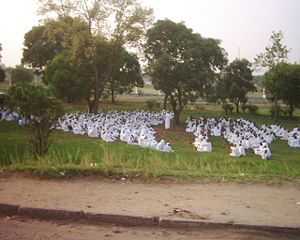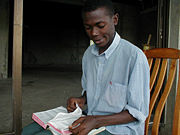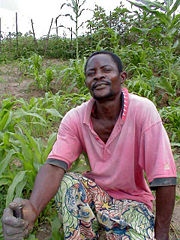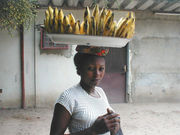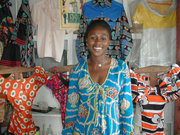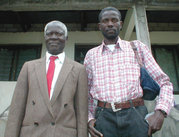Culture of the Democratic Republic of the Congo
2008/9 Schools Wikipedia Selection. Related subjects: African Geography
The culture of the Democratic Republic of the Congo reflects the diversity of its hundreds of ethnic groups and their differing ways of life throughout the country—from the mouth of the River Congo on the coast, upriver through the rainforest and savanna in its centre, to the more densely populated mountains in the far east. Since the late 19th century, traditional ways of life have undergone changes brought about by colonialism, the struggle for independence, the stagnation of the Mobutu era, and most recently, the First and Second Congo Wars. Despite these pressures, the customs and cultures of the Congo have retained much of their individuality. The country's 60 million inhabitants are mainly rural. The 30 percent who live in urban areas have been the most open to Western influences.
People, language and background
Like many African countries, the borders were drawn up by colonial powers, and bore little relation to the actual spread of ethno-linguistic groups. There are around 250 languages spoken in the country, with perhaps a similar amount of ethnic groups. Broadly speaking, there are four main population groups:
- Pygmies, the earliest inhabitants of the Congo, are generally hunter-gatherers who live in the forests. Expert in the ways of the forest, where they have lived for thousands of years, they live by trading meat hunted in the forest with their taller, farming neighbors in exchange for agricultural products. Increasingly, they are becoming absorbed into non-pygmy society, and adopting their languages and customs.
- Bantus arrived in the Congo in several waves from 2000 BC to 500 AD, in most part from the area in what is now southern Nigeria. They are by far the largest group, and the majority live as farmers. They are present in almost every part of the country, and their languages make up three of the five officially-recognized languages. These three languages are Kikongo, Lingala, and Tshiluba. Kikongo is spoken by the Kongo people in the far west of the country, both on the coast and inland, and was promoted by the Belgian colonial administration. Elements of Kikongo have survived amongst the descendants of slaves in the Americas—for instance, the language of the Gullah people of South Carolina contains elements of Kikongo. Lingala, spoken in the capital Kinshasa, is increasingly understood throughout the country, as the lingua franca of trade, spoken along the vast Congo river and its many tributaries. Lingala's status as the language of the national army, as well its use in the lyrics of popular Congolese music, has encouraged its adoption, and it is now the most prominent language in the country. Tshiluba (also known as Chiluba and Luba-Kasai) is spoken in the southeastern Kasai region.
- East Africans brought in the fourth of the official languages, Kingwana—a Congolese dialect of Swahili. Note that the fifth language, French, is the official language of government, a result of Congo's colonial relationship with Belgium. The East Africans are related to the Bantus mentioned above, but tend to differ in their way of life, in that they practice herding as well as farming. They came from the various countries to the east of Congo: Rwanda, Uganda, Burundi and Tanzania, bringing with them many of the ethnic rivalries that have inflamed recent conflicts.
- Hamites, who originally come from Darfur in south part Sudan and Ethiopia, are pastoral cattle raisers. They include the Tutsi, possibly the tallest people in the world. The Hamites also migrated into the Rwanda and Burundi around the same time. Often mixing with the Eastern Africans, they are found in the east and north east of the country, and generally have a more martial culture than other Congolese groups.
The above descriptions are by necessity simplified. Many Congolese are multilingual, and the language used depends on the context. For instance, a government official might use French to set a tone of formality and authority with another official, use Lingala when buying goods at a market, and the local language when in his home village. English is also spoken, especially in the east.
Mixed marriages between ethnic groups are common, particularly in urban areas where many different groups live side by side. Europeans appear in small numbers throughout the country, as missionaries in the countryside, and as businessmen and traders in the cities. Also acting as merchants are small numbers of Lebanese and Pakistanis.
More information on the various peoples in Congo can be found in the Early Congolese History article.
Religions and beliefs
The main religions in the DRC are:
- Indigenous traditional beliefs: 11.5%
- Roman Catholic Christianity: 50%
- Protestant Christianity: 20%
- Indigenous Christianity: 13.5%, nearly all of whom (13%) are followers of Kimbanguism.
- Other Christian denominations: 1%
- Islam: 1.5%
There are small communities of Jews and Hindus who work in commercial urban areas. Atheism is very rare.
Indigenous traditional beliefs
Though only 11.5 per cent of Congolese exclusively follow indigenous beliefs, these traditional belief systems are often intermingled with forms of Christianity, and are familiar to the majority of Congolese. Throughout the DRC the beliefs take on a number of forms, but they have a number of things in common:
- A creator spirit is thought to be sovereign of the spirit world, but this god is rarely the direct cause of events. In many Congolese languages, the name of the creator god derives from the word father or maker. Some groups regard the creator as being omnipresent, whilst others believe the god lives in the sky. For most believers in indigenous religions, contact with the creator god is made via ancestor spirits. A smaller number of groups believe that individuals can have direct contact.
- A belief in an essential life-force which animates the body, The force is thought to leave the body upon death and become an ancestor spirit. These spirits continue to be active in the lives of living relatives—by either punishing or rewarding them. In a similar way to saints in the Catholic tradition, some long-dead ancestors (for instance, great hunters or religious leaders) are venerated by people outside their former family.
- Nature spirits, worshiped mainly in forested regions, are often the embodiment of particular locations such as whirlpools, springs and mountains. The afterlife is believed to exist underground, especially under lakes, where ghostly replicas of Congolese villages reside.
- Fetishes—supernaturally empowered objects which can help or hinder.
- Diviners, witches, dream interpreters and healers act as conduits for supernatural forces.
- Ceremonies and collective prayers—to ancestors, nature spirits and the creator god—are generally performed at particular locations such as sacred trees, grottoes or crossroads. These ceremonies usually take place at a specific time of day. The location and times vary according to the ethnic group.
Belief in Witchcraft is common, and sometimes intersects with the more fundamentalist and evangelical versions of Christianity. In recent years, these beliefs have gained adherents in urban areas, whereas before they were mainly confined to the countryside. The increasing beliefs in witches and sorcery have tended to mirror the social decay caused by war and poverty. Many of the street children that roam the Congo's cities have been cast out of their families after being denounced as witches. These homeless 'witch children' often live in cemeteries and only come out at night, and follow occult practices. See BBC News article on Kinshasa's street children. For comparison, see article on beliefs of Miami street children.
Catholic and Protestant Christianity
Christianity has a long history in Congo, dating back to 1484, when the Portuguese arrived and convinced the king and entourage of the Kongo people to convert. In 1506 a Portuguese-supported candidate for kingship, Alfonso I of Kongo won the throne. Alfonso (the Kongo royal family had begun to take on Portuguese names), established relations with the Vatican. More widespread conversion occurred during the Belgian colonial era. Christianity varies in its forms, and is in some ways surprisingly similar to native beliefs.
During the colonial period, a European-style Christianity was at first promoted by the authorities. Native Congolese generally attended different churches or services than whites. If they worshiped under the same roof, the native Congolese sat on benches at the back, while the whites sat in chairs at the front. Towards the end of the colonial era, more African elements were incorporated into Christianity, including songs and dances which were formerly condemned as pagan. Eventually, even native fables and myths were appropriated and merged into Congolese Christianity, in a similar process to that which occurred with Christianity in Europe.
Recent developments include the increasing popularity of the "Gospel of Prosperity" – a form of Christianity where the emphasis is on wealth acquisition and born-again Christianity. Adherents are led to believe that instant wealth and magical prosperity will result from giving tithes to their charismatic preacher. The leaders often draw on the techniques of American televangelists, and the message is appealing to those living in extreme poverty.
Kimbanguism and Indigenous Christianity
In the first half on the 20th century, prophetic movements sprang up. Their nature was both anti-colonial and Christian, and led to a rigorous crackdown by the authorities.
Simon Kimbangu was the prophet of largest of these movements. He was born in a village near Kinshasa, raised and educated by a Protestant Christian mission and trained to become a priest. In April 1921, at the age of 39, he reportedly had a religious vision of Jesus Christ, who called on him to reconvert his people and dedicate his life to Christ. Kimbangu chose to try to ignore the vision, and fled to Kinshasa where he abandoned his life as a priest and took to menial work. More visions came, and eventually he heeded the calling and returned to his home village and started to devote his life to Christ. Soon after, he is reported to have healed a sick woman by laying his hands on her. Dozens of apparent miracles were subsequently performed by Kimbangu, and he gained followers from surrounding villages and towns. The official Catholic organizations protested to the authorities, and the Protestant church abandoned him. The economic effects of Kimbangu's ministry were being felt, with thousands of Congolese leaving their work to listen to Kimbangu speak. In June the Belgians arrested him for inciting revolution and civil disobedience. Four months later he was sentenced to death. After an international outcry, Albert I of Belgium commuted to the sentence to life impisonment. He died 30 years later in prison, in 1951.
Colonial authorities assumed his movement would wither after his imprisonment and death, but the church continued to flourish underground, and was an effective weapon in the fight against colonialism. In the post-colonial era, its record has been more mixed. Instead of banning the church, Mobutu used a far more effective method of neutralizing it: namely co-opting the church and giving it an official status. Kimbanguism has now spread across the country, and now has branches in nine of the surrounding countries, making it the most popular "native" form of Christianity in Africa. Followers do not smoke, drink alcohol and abhor violence. Monogamy is practiced.
Religion today
Article 22 of the constitution allows for religious freedom. These rights are generally respected by the government . Religious tension exists in some areas because of the link between prophetic groups and paramilitary organizations. In the turbulent eastern region, where the Second Congo War still simmers, some guerrilla groups have a major religious element, believing for instance that they are able to turn enemy bullets into water by wearing certain fetishes.
Food and drink
Less than 2% of land is cultivated, and most of this is used for subsistence farming. People gather wild fruit, mushrooms, honey etc; hunt (see bushmeat); and fish. They will often sell these crops at markets, or by the roadside. Cattle breeding and the development of large-scale agricultural businesses has been hindered by the recent war and the poor quality of the road system.
Congo's farmland is the source of a wide variety of crops. These include maize, rice, cassava (manioc), sweet potatoes, yam, taro, plantain, tomatoes, pumpkin and varieties of peas and nuts. These foods are eaten throughout the country, but there are also regional dishes. The most important crops for export are coffee and palm oil.
Congolese meals often consist of a starchy ingredient, along with vegetables and meat in the form of a stew. The starch can come in the form of a paste or mash made of cassava and/or corn flour, called fufu or ugali. When eaten, the fufu is rolled into golf ball-sized balls and dipped into the spicy stew—often an indentation is made with the thumb in order to bring up a thimbleful of sauce. A type of fermented bread, kwanga, made from cassava, is commercially produced throughout the country. Lituma is a popular plantain dish made from mashed plantains which are formed into balls and baked. Sweet potatoes are prepared in a similar way, and mixed with roasted peanuts in some parts of the country. Rice is often mixed with beans. To accompany these starchy ingredients, green vegetables such as cassava leaves, tshitekutaku (a spinach-like plant) and okra are often added. Mushrooms, especially prized amongst the Luba people, are often seen as a substitute for meat in times of shortage. Though actual vegetarianism is unknown, most meals are eaten without meat due to its high price.
Fish are plentiful along the River Congo, its tributaries, and various lakes; and are baked, boiled or fried for immediate consumption; or smoked or salted when preserved. Markets often sell ready-to-eat peppered fish baked in banana leaves. Goat is the most widely consumed meat. Mwambe is a common way of cooking chicken with peanut sauce. Edible insects such as grasshoppers and caterpillars are eaten; they tend to have a nutty flavour.
Sauces to mix with the ingredients above can be made with tomatoes, onions, and the local aromatic herbs. Vegetable oil, together with salt, hot red chile pepper and sweet green pepper are used to impart extra flavour. These spices are less frequently used in the far south.
Nganda restaurants
Kinshasa's nganda restaurants, with a greater mix of ethnicities, are ethnic restaurants serving food from specific parts of the country, as well as Western imports such as bread and beer. Often owned by unmarried women, the nganda occupy a middle ground between bars and restaurants. Three typical types of nganda restaurants are:
- Riverside nganda serve baked fish served with cooked plantains: recipes from up river.
- Kongo nganda serve fish dishes with a vegetable sauce, together with kwanga mentioned above. These dishes originate downriver from Kinshasa.
* Kasai nganda serve goat meat with rice and green vegetables. They also use rabbit as the grand dessert at a special occasion.
Nganda restaurants are often geared not only to specific regions, but also different classes—from migrant menial workers and miners, to professionals and government officials.
Dress and fashion
Older members of more remote Congolese communities can remember when Congolese used to dress in clothes made of raffia and bark. Today, such clothing is mostly seen only in ceremonial or ritual contexts. Colonialism brought in Western attire. During the Mobutu era, a kind of Mao suit called the abacost (derived from à bas le costume - "down with the suit") was promoted, as part of the Authenticity campaign (whose aim was to move away from Western values). Ties and Western-style jackets were even banned. Since the abacost was relatively expensive, men took to wearing West African style patterned shirts. Ironically, the cloth used for these "authentic" shirts is often imported from the Netherlands and the United States.
For women, the typical clothing today is a wrap made of printed cloth, together with a kerchief to cover the hair. Jewelery is generally kept to a minimum, apart from on special occasions. For men, patterned shirts over trousers, or western-style suits predominate. In urban areas, and amongst Congolese abroad, there is often an emphasis on sharply dressed elegance—this is intricately connected to the subculture of soukous and rumba music. Young Congolese in the cities also look towards African-American Hip hop fashion for inspiration. Several Congolese fashion designers have become successful in Paris.
Music
Zairese/Congolese writers
- Léonie Abo, (1945– )
- Raïs Neza Boneza (1979– )
- Amba Bongo
- Lima-Baleka Bosekilolo
- Maguy Kabamba (1960– )
- Christine Kalonji
- V.Y. Mudimbe (1941– )
- Kavidi Wivine N'Landu
- Clémentine Nzuji (1944– )
- Sony Labou Tansi (1947–1995)
- Kabika Tshilolo
- Frederick Kambemba Yamusangie
- Lye M Yoka
Visual art
The Congo is also known for his art. Traditional art includes masks and wooden statues. Notable contemporary artists are Chéri Samba or Bodys Isek Kingelez.

